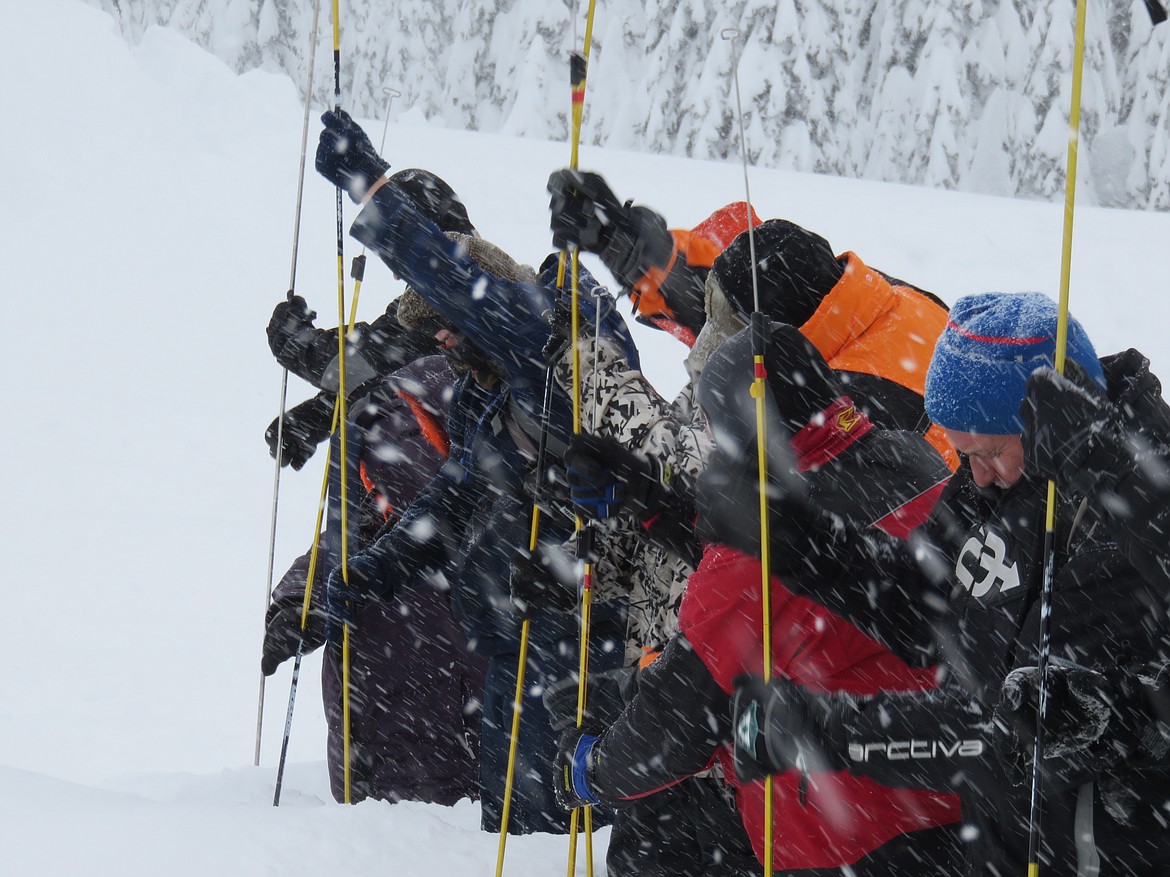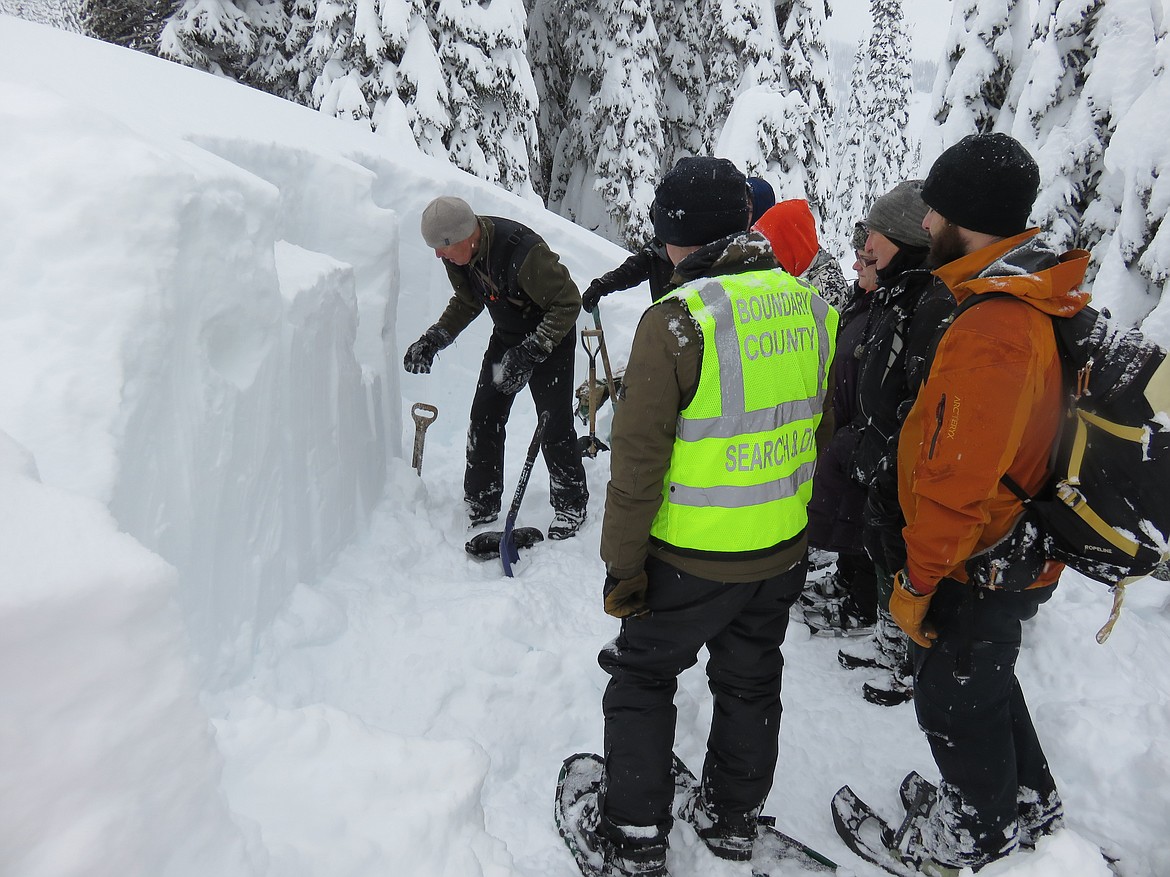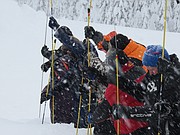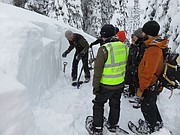Training helps prepare responders, enthusiasts for avalanche risks
Search and rescue specialists — including some from as far as Boundary County, Idaho — met in Libby Jan. 26-27 to receive training and Avalanche Two certification.
The participants also included a few people who simply wanted to be better prepared while out snowmobiling or skiing in avalanche-prone terrain, said Noah Pyle, a volunteer with David Thompson Search and Rescue in Libby.
The training began with a two-hour class that covered some of what goes into avalanche forecasting, the conditions needed for an avalanche, types of avalanches, and precautions that even the more adventurous can take to decrease the likelihood they get caught in an avalanche.
Ben Bernall, an avalanche forecaster with the Idaho Panhandle Avalanche Center — which now serves the area around Libby instead of the Flathead Avalanche Center — talked about the inherently risky pastime of high-marking, and how even there some dangers can be mitigated.
High-marking involves snowmobilers who go up a steep incline and compete to see who can get the highest without having to turn back. The activity accounts for around 64 percent of avalanche fatalities in the U.S., Bernall said.
Yet, by going one at a time, not sitting at the bottom of a slope while watching someone else climb, not attempting to help someone who is stuck and potentially overloading the snow, and staying near the edges of slopes rather than the middle, high-markers can still have fun while removing some risk, he said.
“Playing in avalanche terrain is a game of calculated risk,” Bernall said.
Even with backcountry skiing, snowboarding or snowshoeing, calculated risk comes into play, Bernall told the class.
There are two reasons most people take an interest in understanding avalanches, Bernall said. Either because they want to avoid potential avalanche terrain entirely, or because they want to be in just those areas and know how to spot when the risk outweighs the benefit.
Regardless the activity, most of the precautions Bernall emphasized shared a similar theme: if in doubt, don’t. If there’s no other choice, assess escape routes before crossing, post a lookout, go one at a time and move quickly.
Beyond the classroom, the group went out to Keeler Mountain early in the morning on Jan. 27 to apply some of what they learned. Participants seemed to enjoy the experience — as well as the chili provided by David Thompson volunteers — Pyle said.
At the end, there seemed to be general agreement that everyone, from first-timers to those who show up for the training every year, learned something new.
Throughout the class, Jon Jeresek, a volunteer with David Thompson Search and Rescue, emphasized that there are only 10 true avalanche experts in the country, and none of them were involved in this class.
“I learn every time I go into the mountains. I learn every time I dig snow. I learn every time I go to avalanche.org,” he said. “Does anybody know everything? Nuh-uh.”
Out at Keeler Mountain, Jeresek demonstrated how to dig a pit to examine the snowpack and make test columns to check avalanche potential, Pyle said. Bernall worked with participants on finding dummies used to simulate people trapped by an avalanche.
There were two methods used for finding the dummies, Pyle said. For one, participants walked in a line and used long poles to probe the snow for the dummy until a search dog was brought in.
Before the dog showed up, the progress for the probe line was slow, and several minutes passed before the dog could be deployed, he said.
The second method involved a dummy with a transceiver, which allowed the participants to quickly locate it with another transceiver, Pyle said.
In a real avalanche scenario, that difference in time could be a matter of life and death, Jeresek said.
In the class, he said that if someone is recovered from an avalanche in under 5 minutes — assuming no internal trauma — the survival chance is almost 100 percent. At 30 minutes, the survival rate for the same conditions drops to 30 percent.
Most avalanche fatalities — 65 percent — are from the person running out of breathable air, Jeresek said.
As a result, if two people are in avalanche terrain and one is trapped in an avalanche, the person on scene is the search party, he said. Any help that can be summoned is unlikely to arrive in time to save the trapped person.
People also need to be cautious with how they carry their transceivers, Jeresek said. Any electronic device or even metal alone can interfere with how well a transceiver works. Cell phones and other electronic devices should be shut off, and they should be carried about 20 inches away from the transceiver.
Jeresek told the class about a fatality in Canada involving a woman with a magnetic closure on her jacket. The magnets changed the setting on the transceiver, and when an avalanche buried her, there was no signal to locate her by.
Still, there is a positive side, especially in Montana, Jeresek said. For some time, snowmobilers had been about 75 percent of avalanche fatalities. That number has come down to around 50 percent, and there appears to be a downward trend over the past five years.
For the past several years, a lot of the training has been targeting snowmobiling enthusiasts in an attempt to get just that result, he said.
“The overall numbers are coming down. The percentage of fatalities too,” Jeresek said. “We’ve been waiting for that for a long time, and there’s probably nobody happier than me to see that trend.”
Resources:
Idaho Panhandle Avalanche Center (idahopanhandleavalanche.org): Interactive map of avalanche forecasting around Libby and into Idaho.
Avalanche.org: Nationwide map with interactive sections for avalanche forecasts, and links to educational and other resources
Flathead Avalanche Center (flatheadavalanche.org): Interactive map of avalanche forecasting around Kalispell area.







